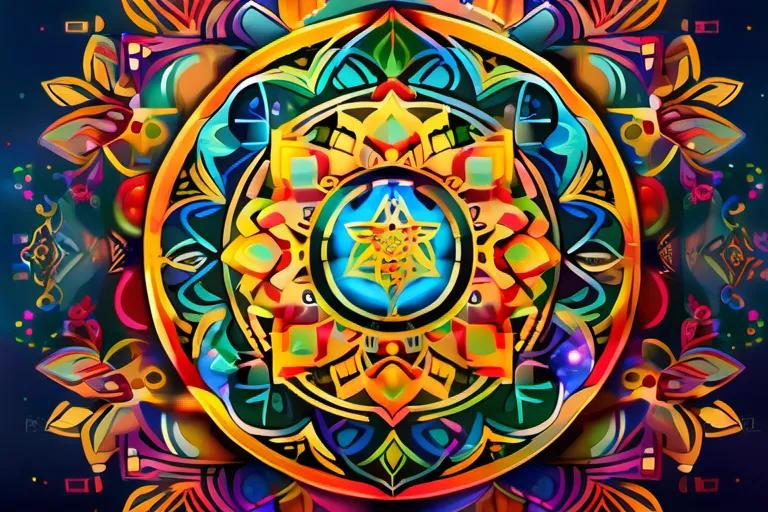Exploring the key beliefs, practices, and characteristics that define new religious movements
New religious movements (NRMs) have emerged throughout history, offering unique perspectives on life, the universe, and everything in between. In this article, we will delve into the central principles that define these movements and explore their impact on society.
The Origins and Emergence of New Religious Movements
The origins and emergence of new religious movements (NRMs) are like seeds scattered across history, sprouting in different environments, each bearing unique fruits. But what factors nurture these seeds? How do cultural, social, and political climates give rise to NRMs?
Is it the disillusionment with mainstream religions or the desire for something fresh that pushes people towards NRMs?
- Historically, religious movements have often arisen during times of great upheaval, whether in response to societal changes, political unrest, or economic shifts. Think about how the Protestant Reformation was a reaction against the corruption and complexity of the Catholic Church.
- Cultural factors also play a significant role. For instance, the rise of NRMs has often mirrored broader trends in society, such as increased globalization, technological advancements, and changes in communication methods.
Consider how the internet has become a platform for NRMs to flourish, allowing them to spread their beliefs beyond geographical boundaries. The social fabric is woven with threads of diversity, and it’s within these complex patterns that new religious movements find a place to thrive.
The political climate also leaves its mark on religious landscapes. In times of conflict or repression, marginalized groups may turn inward, developing their own spiritual practices and beliefs as a means of resilience and identity formation.
Looking at the historical context, it becomes clear that NRMs are not isolated phenomena but integral parts of broader social and cultural shifts. They reflect the aspirations, fears, and desires of those who seek meaning in an ever-changing world.
So, as we delve into the key beliefs and practices of these movements, remember how they are deeply intertwined with their historical contexts. Understanding one without the other is like trying to grasp a shadow in the light—both essential but incomplete on their own.
Key Beliefs and Practices of New Religious Movements
When we delve into the key beliefs and practices that define new religious movements, it’s like exploring a vast garden filled with unique flowers. Each movement has its own distinct petals—rituals, symbols, sacred texts—that bloom in fascinating ways. How do these elements intertwine to create something so powerful and transformative?
Rituals are the heartbeat of many new religious movements. They can be as simple as a daily prayer or as elaborate as a month-long festival. What do these rituals symbolize? Are they meant to connect participants with a higher power, or perhaps to reaffirm their identity within the group? Think about it—when you witness someone performing a ritual, are you seeing a window into their deepest beliefs and values?
Symbols play a crucial role in new religious movements. From the crosses of Christian movements to the lotus flowers in Buddhism, symbols are more than just visual representations; they carry profound meanings. How do these symbols influence members’ behaviors and thoughts? Are they tools for meditation or guides for daily living? Reflect on how a symbol can subtly shape an individual’s perception of reality.
Sacred texts are another cornerstone of many new religious movements. Whether it’s the Bible, the Quran, or other scriptures, these texts often contain teachings that members consider divine or authoritative. How do they interpret and apply these teachings in their lives? Do they see them as a source of moral guidance or spiritual inspiration? Imagine holding a sacred text; what insights might you gain into the beliefs and practices of those who revere it?
These elements—rituals, symbols, and sacred texts—are not merely static components but dynamic forces that shape the identity and direction of new religious movements. By understanding these core aspects, we can better grasp how these movements offer a sense of community, meaning, and purpose to their followers. Are you curious about what lies behind the rituals, symbols, and texts of these diverse spiritual journeys?
The Role of Charismatic Leaders in New Religious Movements
The role of charismatic leaders in new religious movements can be compared to that of a compass in navigating uncharted territories. These leaders often emerge as guides, steering their communities through complex spiritual landscapes and providing direction when followers may feel lost or uncertain. How do they manage to command such respect and devotion?
Charismatic leaders are frequently seen as possessing unique gifts or knowledge that set them apart from others. They might claim to have direct communication with the divine, prophetic visions, or personal experiences that validate their spiritual authority. Their ability to articulate complex ideas in simple, compelling terms makes them effective communicators and powerful influencers.
But how do these leaders maintain their hold over followers? Often, it’s through a combination of emotional manipulation and moral persuasion. They create an environment where loyalty is expected and dissent is discouraged. Through rituals, symbolism, and regular preaching, they reinforce the importance of obedience and commitment to the movement’s goals.
The impact of such leaders can be profound. They not only shape the beliefs and practices of their followers but also influence societal norms and values. For example, some movements advocate for social justice, environmentalism, or radical forms of spirituality that challenge mainstream religious institutions. This can lead to both positive change and controversy within wider society.
Moreover, charismatic leaders often play a significant role in the spread and success of new religious movements. Their personal magnetism can attract converts from various backgrounds, expanding the movement’s reach and influence. Yet, their power also makes them targets for criticism or even persecution by those who view their teachings as heretical or dangerous.
In summary, charismatic leaders are pivotal in shaping the trajectory of new religious movements. They serve not only as spiritual guides but also as social architects, carving out spaces that challenge and reshape cultural landscapes. Their influence is far-reaching, touching both individual lives and broader societal structures.
The Social and Cultural Impact of New Religious Movements
How do new religious movements shape our understanding of identity and community? These fresh spiritual currents often emerge as powerful forces within society, mirroring broader cultural shifts and challenges. Are these movements simply a reaction to modernity’s uncertainties, or are they more than that?
Consider the metaphor of a river carving through a landscape; new religious movements can be seen as streams branching out from the main flow of traditional beliefs. They carry unique messages, drawing followers with their fresh perspectives and innovative practices.
- Identity: How do these movements help individuals find meaning in an increasingly secular world? They often offer a sense of belonging and purpose that can be hard to find elsewhere.
- Community: In what ways do they foster social bonds among members, perhaps through shared rituals or practices? This sense of community can be especially appealing during times of social isolation or upheaval.
- Values: New religious movements often emphasize values that resonate with contemporary issues. For example, environmentalism and social justice might play significant roles in their teachings.
The impact of these movements is not one-sided; they also reflect and influence broader societal trends. How do changes in technology, globalization, or political climates shape the emergence and evolution of new religious movements? And conversely, how do these movements contribute to shaping public opinion on various social issues?
For instance, consider a movement that promotes digital spirituality. In what ways might this reflect our growing reliance on technology for communication and interaction? Could it also challenge traditional notions of privacy or personal space in the virtual realm?
Understanding new religious movements is crucial not only for scholars but also for anyone seeking to navigate the complex landscape of modern belief systems. These movements offer a window into human spirituality, demonstrating how our search for meaning continues to evolve alongside societal changes.
The Challenges and Controversies Surrounding New Religious Movements
Understanding the central principles of new religious movements (NRM) can feel like delving into a complex puzzle, where each piece represents a unique belief system. These movements often emerge from dissatisfaction with established religions and seek to fill spiritual voids in individuals’ lives. Have you ever wondered why some people leave their traditional faiths to join these groups? It’s not just about seeking a new church; it can be about finding a sense of belonging or a deeper understanding of the divine.
One key characteristic of NRMs is their emphasis on personal transformation and spiritual growth. They often encourage members to question societal norms and challenge conventional wisdom, much like breaking free from a cocoon to become a butterfly. This process can be transformative but also controversial. Critics might view this as a form of brainwashing or manipulation, while supporters see it as an empowering journey towards self-discovery.
Another important aspect is the role of leadership within these movements. Often, charismatic leaders play pivotal roles, guiding their followers with fervor and conviction. This can be both inspiring and problematic, as such figures can wield significant influence over their members’ lives. How do we distinguish between genuine spiritual guidance and authoritarian control? It’s a question that haunts many NRMs.
NRMs also face numerous challenges, including persecution and discrimination from mainstream society. These groups are sometimes seen as cults or fringe communities, which can lead to legal scrutiny and social ostracization. The line between legitimate religious practice and dangerous behavior is often blurry, making it difficult for authorities and the public to decide how to respond. Have you ever considered the impact of societal prejudice on these movements?
The assimilation process into mainstream society is another hurdle NRMs must navigate. As they grow in size and influence, they are forced to adapt to cultural norms while maintaining their unique identities. This balancing act can be challenging, as it requires them to redefine themselves continually without losing their core beliefs.
The Future of New Religious Movements
As we look to the future, one cannot help but ponder how new religious movements (NRM) will evolve and adapt in our rapidly changing world. Are these groups destined for growth, or are they facing extinction? It’s a question that touches on the very heart of human belief and spiritual exploration.
Will NRM continue to captivate individuals seeking unique spiritual paths? In today’s diverse and interconnected societies, there is a growing appetite for spirituality that goes beyond traditional religious boundaries. New religious movements often offer fresh perspectives and practices, which can be incredibly appealing in a world where conventional faiths sometimes feel stale or restrictive.
Imagine a future where new religions become more integrated into mainstream society. How might these groups influence broader cultural and social trends? Could they play a pivotal role in addressing global issues such as environmental sustainability or social justice?
The adaptability of NRM is another crucial factor to consider. Just like any living organism, these movements must evolve to survive. They need to address the changing needs and beliefs of their members while maintaining their core values and practices. This balance can be challenging but is also what keeps them vibrant and relevant.
Moreover, with the advancements in technology and globalization, NRM might find new ways to spread their messages and attract followers. Social media platforms could become a powerful tool for reaching people from all corners of the world, offering a platform that was unimaginable just a few decades ago.
But will these movements thrive or simply fade away in the face of traditional religious institutions that have deep roots? It’s a question that requires careful examination. While established religions may offer stability and tradition, NRM can provide innovation and personal growth that some individuals find more fulfilling. As people continue to seek meaning beyond materialism, new religious movements might just be the next step in human spiritual evolution.
The future of NRM is a tapestry woven with threads of uncertainty and potential. Will these groups become as influential as ever, or will they remain marginal? Only time will tell, but one thing is certain: they continue to offer a mirror through which we can examine the evolving nature of human spirituality in an increasingly complex world.
Conclusion
 By understanding the core beliefs and practices of new religious movements, we can gain a deeper appreciation for the diversity of human belief systems and the role they play in shaping our world. Whether you are a scholar, a seeker, or simply curious, this article will provide valuable insights into the fascinating world of NRMs.
By understanding the core beliefs and practices of new religious movements, we can gain a deeper appreciation for the diversity of human belief systems and the role they play in shaping our world. Whether you are a scholar, a seeker, or simply curious, this article will provide valuable insights into the fascinating world of NRMs.











